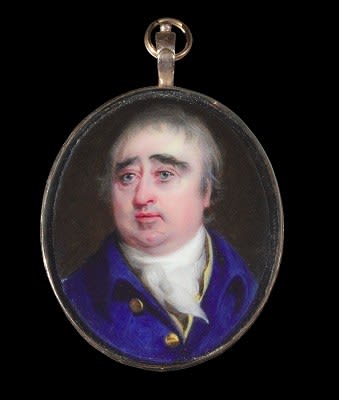
Horace Hone
Portrait enamel of the Rt. Hon. Charles James Fox (1749-1806), 1810
Enamel on copper
Oval, 1 ½ inches (3.8 cm) high
Philip Mould & Co.
To view all current artworks for sale visit philipmould.com Gilt frame with incised edge and glass reverse. Inscribed on the counter-enamel: The Rig. Hon/Charles J. Fox./Horace Hone ARA./Pinx. 1810./London...
To view all current artworks for sale visit philipmould.com
Gilt frame with incised edge and glass reverse.
Inscribed on the counter-enamel: The Rig. Hon/Charles J. Fox./Horace Hone ARA./Pinx. 1810./London
Horace Hone was the second son of the Irish portrait painted Nathaniel Hone and entered the Royal Academy Schools on 19th October 1770 at the age of sixteen. From1782 Hone worked in Dublin where he established a successful practice no doubt assisted by the reputation of his father. When England was united with Ireland in 1800 Hone’s patronage dwindled and in 1804 he relocated to London whilst also spending a period in Bath. In 1795 Hone became miniature painter to the Prince of Wales and he maintained an illustrious list of patrons throughout his life including Sarah Siddons who first sat in 1784 [National Gallery of Ireland] as well as numerous members of the nobility. The present enamel is a posthumous portrayal of Fox and is after the original head type by Sir Thomas Lawrence painted c.1800 [Private Collection]. Intriguingly in 1810, the same year the present work was conceived, Hone exhibited at the Royal Academy ‘[A] Frame containing portraits of the Rt. Hon. C.J. Fox, a lady and a Madonna, after Carlo Dolci; enamels’ and although impossible to say for certain, the mentioned portrait could very well be the present work.
Charles James Fox is a figure so central in the understanding of late eighteenth century politics, that the observer might be forgiven for imagining that he had been Prime Minister or at the very least that he had regularly held the highest offices. This could not be further from the truth, and with the exception of a brief period as Foreign Secretary, significant position eluded him. He remains a figure of such note, however, for particular reasons of his genius and, it must be said, of his birth. In addition to these advantages, Fox was undeniably gifted with one of the most agile minds of his age and with an exceptionally winning personality. Only an addiction to gambling, which resulted in vast debts that his father paid unhesitatingly, hinted at the dissipation that would haunt him for the rest of his life. Unlike the shambling figure that would later be caricatured by Gillray Fox in his youth had once been known as one of London's foremost macaronis.
These convivial qualities never left Fox, and the allies who commissioned portraits of him were his friends and dinner companions as well as his political disciples.
Gilt frame with incised edge and glass reverse.
Inscribed on the counter-enamel: The Rig. Hon/Charles J. Fox./Horace Hone ARA./Pinx. 1810./London
Horace Hone was the second son of the Irish portrait painted Nathaniel Hone and entered the Royal Academy Schools on 19th October 1770 at the age of sixteen. From1782 Hone worked in Dublin where he established a successful practice no doubt assisted by the reputation of his father. When England was united with Ireland in 1800 Hone’s patronage dwindled and in 1804 he relocated to London whilst also spending a period in Bath. In 1795 Hone became miniature painter to the Prince of Wales and he maintained an illustrious list of patrons throughout his life including Sarah Siddons who first sat in 1784 [National Gallery of Ireland] as well as numerous members of the nobility. The present enamel is a posthumous portrayal of Fox and is after the original head type by Sir Thomas Lawrence painted c.1800 [Private Collection]. Intriguingly in 1810, the same year the present work was conceived, Hone exhibited at the Royal Academy ‘[A] Frame containing portraits of the Rt. Hon. C.J. Fox, a lady and a Madonna, after Carlo Dolci; enamels’ and although impossible to say for certain, the mentioned portrait could very well be the present work.
Charles James Fox is a figure so central in the understanding of late eighteenth century politics, that the observer might be forgiven for imagining that he had been Prime Minister or at the very least that he had regularly held the highest offices. This could not be further from the truth, and with the exception of a brief period as Foreign Secretary, significant position eluded him. He remains a figure of such note, however, for particular reasons of his genius and, it must be said, of his birth. In addition to these advantages, Fox was undeniably gifted with one of the most agile minds of his age and with an exceptionally winning personality. Only an addiction to gambling, which resulted in vast debts that his father paid unhesitatingly, hinted at the dissipation that would haunt him for the rest of his life. Unlike the shambling figure that would later be caricatured by Gillray Fox in his youth had once been known as one of London's foremost macaronis.
These convivial qualities never left Fox, and the allies who commissioned portraits of him were his friends and dinner companions as well as his political disciples.
Exhibitions
Probably Royal Academy, London, 1810, no.631Be the first to hear about our available artworks
* denotes required fields
We will process the personal data you have supplied in accordance with our privacy policy (available on request). You can unsubscribe or change your preferences at any time by clicking the link in our emails.